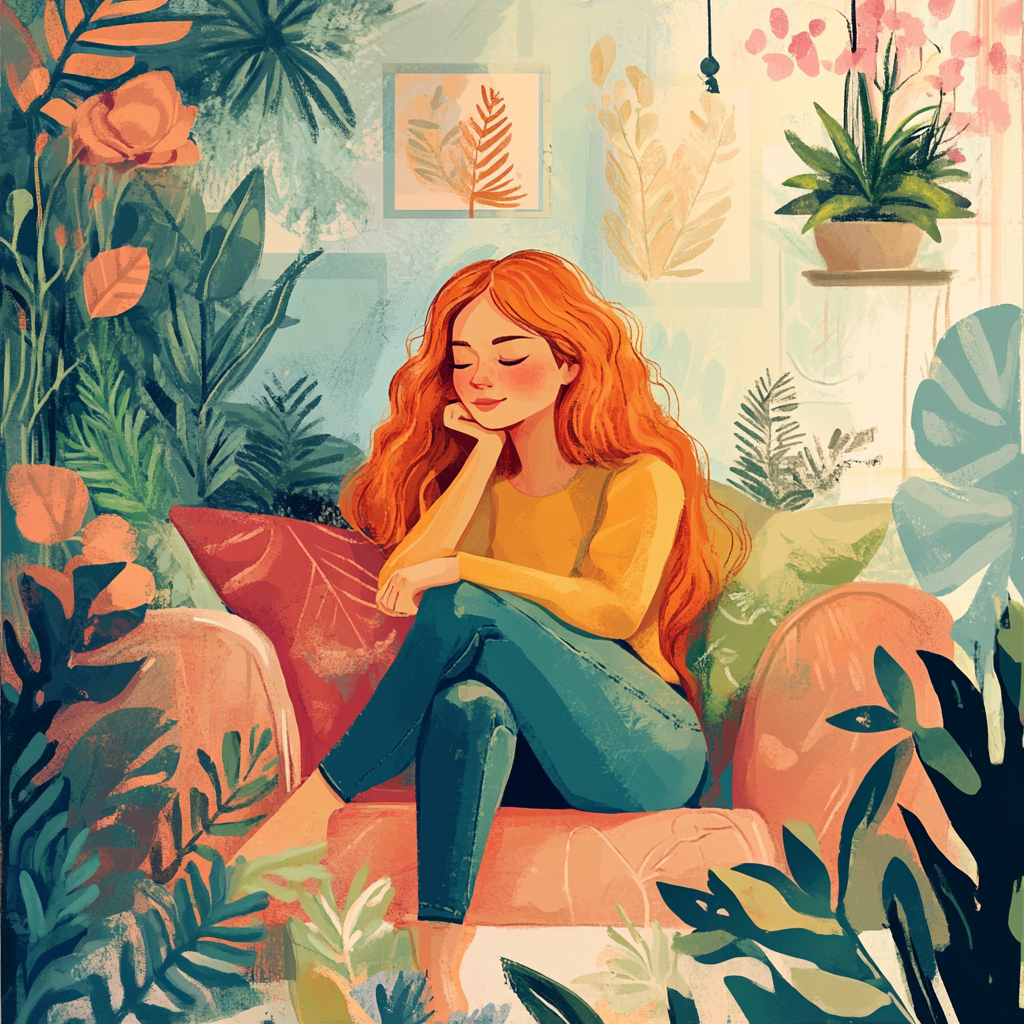If you often find the world a bit overwhelming—whether it’s bright lights, loud sounds, or the general hustle and bustle—you’re not alone!
Managing sensory sensitivities and nervous system dysregulation can feel like a full-time job. But with the right hacks, it’s totally possible to make your day-to-day experiences calmer and more enjoyable.
We’ve compiled a list of handy tips for grocery shopping, travel, social outings, and more to help you stay centered, calm, and ready to take on the world—at your own pace.
Shopping
Groceries Simplified
The grocery store can feel like a sensory battlefield. Lights, scanners, clashing carts and that’s before you’ve even hit the fragrance aisle. Here’s how to keep your cool and make shopping a little more bearable:
- Shop During Sensory-Friendly Hours
Some stores offer sensory-friendly shopping hours, with dimmed lights and less noise (Whole Foods, Tesco, and certain Walmart locations do this). If your local store doesn’t have this option, consider suggesting it to them! - Online Grocery Shopping
Why not skip the store altogether? Take advantage of Instacart, Amazon Fresh, or your local grocery store’s delivery service and order everything from home—no crowds, no noise. - Bring Your Own Headphones
If in-store shopping is a must, pop in some earplugs or listen to your favorite calming tunes on noise-canceling headphones. - Pre-Order for Pickup
Many stores offer curbside pickup, so you can order your groceries online and have them delivered straight to your car. - Small Stores, Less Overwhelm
Opt for smaller, local markets that are typically quieter and less crowded than big supermarkets. Smaller chains may also be more open to offering sensory-friendly shopping experiences.
Clothes Shopping for Comfort
Wearing comfy clothes doesn’t mean you have to look like you’ve raided the wardobe of the local nursing home. Here’s how to be stylishly comfortable:
- Soft Fabrics
Hunt down brands that use soft, sensory-friendly materials. Think brands like Bamboo Body, Pact, or Thought Clothing for a cozy feel that won’t irritate. P.S. For nightwear, I LOVE The White Company’s P.J.’s! - Opt for Loose, Comfortable Clothing
Go for relaxed, non-restrictive outfits with stretchy waistbands. I love some of the easy-breezy dresses at Free People. And for trousers – well I could live in harem pants. - Shop Online
Skip the sensory overload of crowded stores and shop online. It’s a quieter way to get your shopping fix. - Choose Non-Itchy Materials
Steer clear of scratchy fabrics like wool or certain synthetics. Look for comfy materials like cotton, bamboo, or modal that are gentle on your skin. - Tagless and Seamless Options
Seek out tagless or seamless clothing to avoid those pesky itches and seams. Brands like Hanes and Intimissimi have got you covered.
Travel
Stress-Free Airline Adventures
Airline travel can be INTENSE, but the destination is often worth it. Here’s how to make it more enjoyable:
- Airport Lounges for the Win
If you can budget for it, airport lounges offer quieter, more peaceful places to relax before a flight. Some lounges even come with dim lighting and comfy chairs. - Meditate in the Prayer Room
Many airports have prayer rooms or quiet zones—perfect for a quick moment of peace and meditation away from the busy terminal. - Off-Peak Travel is Your Best Friend
Plan your trips during off-peak times (mid-week or early morning flights) to avoid the worst of the crowds. - Calm Apps for Travel Zen
Download apps like Calm or Headspace for guided meditations or relaxing sounds to ease the stress of travel. - Bring a Travel Comfort Kit
Pack essentials like a neck pillow, a soft blanket, and some soothing tea to make your journey as cozy as possible. You can always just ask for some hot water at the airport or on the plane for your tea! - Book Direct Flights
Opt for direct flights to avoid the stress and sensory overload of layovers and multiple airport experiences. - Skip the Queue
Make your airport experience smoother by looking into passes for priority boarding and fast-track security. It’s a quick way to dodge long lines and reduce the sensory overload that comes with crowded terminals.
Vacation Planning – Travel Booking Tips
Alright, we’ve got the airport sorted—now let’s tackle other ways to get around, plus tips for planning, packing, and picking your destination:
- Bring Your Own Bedding
Pack your own pillowcase or blanket for a touch of home comfort, even in unfamiliar spaces. - Travel During Low Seasons
Go for vacations when it’s quieter. Off-season trips mean less crowd and more relaxation. - Choose Tranquil Destinations
Seek out serene spots like secluded beaches, peaceful mountains, or cozy rural retreats for the ultimate calm. - Research Sensory-Friendly Hotels
Find hotels with quiet rooms, blackout curtains, and minimal noise for those restful vibes! - Create a Packing Checklist
Make a list of your sensory-friendly must-haves—think eye masks, earplugs, and light filtering glasses. - Opt for Slow Travel
Embrace slower travel modes like road trips or trains for a more relaxed journey if you prefer to skip the airport hustle entirely. - Self-Catered Accommodations
Pick places with kitchens so you can cook your own meals. It’s a great way to avoid restaurant overwhelm.

Commute in Calm
Dysregulated or not, no-one enjoys commuting. Here are our favorite ways to make your daily travel more comfortable.
- Use Sensory-Friendly Public Transport Hours
If you can, travel during off-peak times when public transport is less crowded and noisy. This may look like getting out the door earlier, or asking for more flexible working hours so you can avoid rush hour. - Bring a Calming Playlist
Create a playlist of soothing tunes or nature sounds to help drown out the chaos and keep you calm on your journey. - Carpool with Like-Minded Friends
Share rides with friends or coworkers who get your need for a quiet, peaceful commute. - Book First-Class or Quiet Zones
Look for train and bus options with quiet zones or first-class seats. These options are often much less busy in general. - Download E-Books or Audiobooks
Keep an audiobook or a soothing e-book handy. It’s a great way to distract yourself from the stress of travel. - Bring Comfort Items
Pack a cozy scarf or a portable pillow for long trips. Little comforts can make a big difference. - Monitor Traffic Apps
Use apps like Waze or Google Maps to dodge traffic jams and find the smoothest route. Less time in traffic means less stress. Always.
At Work and At Home
Find Your Work/Study Zen
Whether you’re working or studying, a noisy or cluttered environment can easily throw you off. Here’s how to stay on track:
- Set Up a Quiet Workspace
Choose a space that’s free from distractions and consider noise-canceling headphones or Loop Quiet Earplugs to keep things serene. - Scheduled Breaks for Reset
Use apps like Pomodoro timers to remind yourself to take short breaks. A quick stretch or a few deep breaths can do wonders! - Declutter Your Desk
Keep your workspace tidy to reduce visual clutter and maintain focus. Desk organizers are your new best friend. - Productivity Apps
Apps like Forest help you stay focused by “growing trees” while you work. If you leave the app, the tree dies! Nobody wants a dead tree on their hands. - Request Work-from-Home Days: If your job allows it, ask your employer if you can work from home— even just one day a week. This can give you a much-needed sensory break, helping you recharge in a calmer, more controlled environment.
Create Your Personal Sanctuary
Your home should be your safe space, where you can unwind and recharge. Here’s how to make it sensory-friendly:
- Dim the Lights
Switch out harsh overhead lighting for dimmable lamps or use salt lamps for a soft, calming glow. - White Noise Machines
Block out disruptive sounds with a white noise machine. You can also use apps that play nature sounds or gentle background noise. - Minimalist Décor for the Win
Keep your space clutter-free! Minimalist décor helps reduce visual overstimulation and creates a peaceful atmosphere. - Indoor Plants
Bring nature indoors with a few low-maintenance plants. They don’t just look good—they help purify the air and promote calmness.

Socialising and Public Spaces
Social Fun – Without the Overload
Socializing can be tricky when you’re sensitive to noise, crowds and other stimuli. Here’s how to enjoy it on your terms:
- Choose Quiet Venues
Pick more relaxed venues, like a cozy café or an outdoor park, to avoid loud, crowded environments. - Shorter Visits, More Fun
It’s okay to limit your time at social events. Stay for a bit, take breaks as needed, and then head home when you’re ready. - Communicate Your Needs
Don’t be shy—let friends or family know what environments work best for you. Most people are more than happy to accommodate. If they’re not – they ain’t your people. - Host at Home
If you’re feeling up for it, host gatherings at your place so you can control the environment and take breaks as needed. Skip the cooking—crudités, hummus, dips, and cold meats are easy, no-fuss winners every time. - Use Fidget Tools
Carry discreet fidget tools like Tangle or Squeeze Balls to manage sensory overload in social settings.
Keep It Chill Dining Out
Dining out can be a sensory overload; clattering silverware, rowdy diners, and all those foodie smells. Try these tricks to help keep things calm:
- Early or Late Dining
Opt for off-peak dining hours when restaurants are quieter and less crowded. - Request a Quiet Table
Ask for a table away from busy areas, like the kitchen or bar, to enjoy a more peaceful meal. - Take-Out is Your Friend
Order take-out from your favorite spot and enjoy it in the comfort of your home—no noise, no stress. - Ear Plugs, Ear Plugs, Ear Plugs
Staying Comfortable in Public Spaces
Navigating public spaces can be a sensory rollercoaster, right? Here’s some tricks to help minimize the hustle and bustle.
- Choose Off-Peak Times
Hit up parks, zoos, or malls during their quiet hours—think midweek mornings at the mall or a peaceful stroll through the zoo on cloudy weekdays. Less chaos, more calm. - Noise-Canceling Earbuds
Yup. We’re mentioning them again. Loop Quiet Earplugs will become your new bff. They’re your personal sound barrier against overwhelming background noise. - Scope Out Quiet Zones
Seek out those hidden quiet zones—find meditation rooms, sensory-friendly areas, or cozy cafe corners where you can sneak away and recharge. - Carry a Calming Toolkit
Pack a calming toolkit with goodies like rescue remedy, nervous system regulating devices, or calming aromatherapy rollers. It’s like your portable relaxation kit. - Be Mindful of Lighting
Avoid harsh lights or pop on some tinted glasses. Keep the glare at bay and seek out places such as restaurants, venues and retailers with softer, more soothing light. Or just conduct all your social outings in Hollister. - Use Color Therapy Glasses
Slip on color therapy glasses with calming hues, like green or blue, to help ease visual overstimulation when you’re out and about. - Pre-Plan Exits
When heading to events, plan your exit strategy in advance. Having a clear way out can help you handle overwhelming situations better.
Rest and Relaxation
Pamper Time
Taking care of yourself should feel good, not overwhelming. Ditch synthetic fabrics and chemical-laden products to create a sensory-friendly routine:
- Soft, Breathable Fabrics
Pick clothing made from soft materials like bamboo or cotton to keep your skin comfortable all day long. - Low-Fragrance Products
Choose unscented or mildly scented skincare and hygiene products to avoid overpowering smells. - Comfortable Footwear
Shoes should be like walking on clouds—look for soft, cushioned options like Allbirds or Seevees. - Treat Yourself Regularly: Make time for some well-deserved pampering, whether it’s a long bath with Epsom salts or a DIY spa day. These little rituals can work wonders for stress relief.
- Wrap Yourself in Comfort: When stress hits, cozy up in a snug body wrap or adult swaddle. It’s like giving yourself a great big snuggly, buggly, hug.
- Go Fragrance-Free for Your Laundry: Ditch the overpowering scents by switching to fragrance-free laundry detergents. Your clothes will be fresh without any sensory overload.
Snoozin’ and Sleepin’
Good sleep is crucial for managing sensory sensitivity. Try these tips for the perfect snooze routine:
- Weighted Blankets: These blankets provide deep pressure stimulation that can help you feel grounded and safe, helping you sleep more soundly.
- Soothing Sounds: Try calming sound apps, like ocean waves or rain, to help you drift off.
- Set Your Sleep Scene: Use blackout curtains or blinds and soft bedding to make your bedroom a soothing sleep sanctuary.
- Stick to a Routine: Keep your body’s clock in check by sticking to a consistent sleep schedule. It’s the secret sauce for better rest and brighter mornings.
Digital Detox
Our devices can be a big cause of sensory overload and nervous system dysregulation. Try these tips to get a handle on any bad tech habits:
- Delete Old Emails: Keep your inbox clear by deleting unopened or old emails to prevent the hideous and overwhelming sight of hundreds of unread messages.
- Close Browser Tabs: Ever feel like you have too many tabs open in your brain? Close the physical ones you aren’t using to help reduce mental clutter and stick to the “one-task tabs” rule: only keep open the tabs you need for your current task.
- Use Blue Light Filter Glasses
These glasses help reduce eye strain from staring at screens all day—plus, they look pretty cool. - Take Charge of Screen Time: Give yourself a digital detox by setting daily limits and taking regular breaks. Your eyes (and nervous system) will thank you.
- Dial Down the Brightness: Adjust your device’s brightness and contrast for a softer, more comfortable viewing experience. Less strain, more zen.
- Cut the Notification Clutter: Turn off non-essential notifications so you’re not constantly interrupted by dings and pings.
- Schedule ‘Screen-Free’ Times
Pick specific times each day to unplug from screens. It’s like giving your brain a mini-vacation to help fend off sensory overload. - Limit Social Media
Cut back on social media time to avoid overstimulation and the stress of constant comparison. Your peace of mind is worth more than knowing Lana Del Rey’s latest drama.

Health and Wellness Hacks
Mind and Body Well-Being
Looking to boost your well-being? Start here:
- Grounding Mats
Step onto grounding mats that mimic the feeling of walking barefoot on natural surfaces. They can help soothe and balance your nervous system. - Therapy Tools
Dive into sensory therapy tools like weighted blankets, compression vests, or sensory swings to keep your nervous system in check. - Low-Stimulation Workouts
Try gentle exercises such as tai chi, yoga, or pilates in calming spaces. They’re great for reducing stress without sensory overload. - Take Short Breaks
Incorporate quick relaxation breaks throughout your day. These mini resets can help manage stress and keep you feeling balanced. - Use Mindfulness Apps
Download apps like Insight Timer or Buddhify for daily guided relaxation. They’re perfect for unwinding and staying centered. - Try Acupuncture
Consider acupuncture or acupressure to balance your energy levels and ease sensory overload. A bit of needle therapy might be just what you need! - Hydrate Regularly
Stay hydrated—drinking water helps keep stress and discomfort at bay. And no, your 10-a-day Starbucks latte habit doesn’t count. - Consult a Nutritionist
Team up with a nutritionist to craft a diet that supports your nervous system and helps manage sensory sensitivities. Good eats equals good vibes.
Daily Routines
Start your day off right by making your daily routine more sensory-friendly:
- Wake Up Gently: Swap out the jarring alarms for soothing tones or gentle vibrations. Nobody needs to wake up with a pounding heart.
- Prepare Soothing Morning Sounds
Start the day with soothing nature sounds instead of diving straight into your phone. It’s a gentle way to ease into your morning. - Morning Stretch Routine
Incorporate a few minutes of gentle stretching or yoga into your morning routine to wake up your body and mind in a relaxing way. - Mindful Breakfast
Enjoy a mindful breakfast away from screens. Focus on the textures and flavors of your meal to start your day grounded and present. - Routine Check-Ins
Take a few moments for quick, mindful check-ins with yourself throughout the day. It’s an easy way to keep calm and stay grounded.
Personal Boundaries
Setting and maintaining personal boundaries is critical for your wellbeing. Here’s how to do it:
- Establish Boundaries
Clearly communicate with family, friends, and colleagues about your need for sensory-friendly spaces. Let them know what works best for you. - Say No Without Guilt
It’s okay to turn down invitations or obligations if they might overwhelm you. Practice saying no without feeling bad about it. - Self-Care Days
Schedule regular self-care days to recharge your batteries, free from any obligations. You NEED time to unwind and refresh.
These tips are here to help you stay comfy and in control of your surroundings. Whether you’re planning ahead, tweaking your environment, or using clever sensory tools, you can find a way to make the world work for you.

